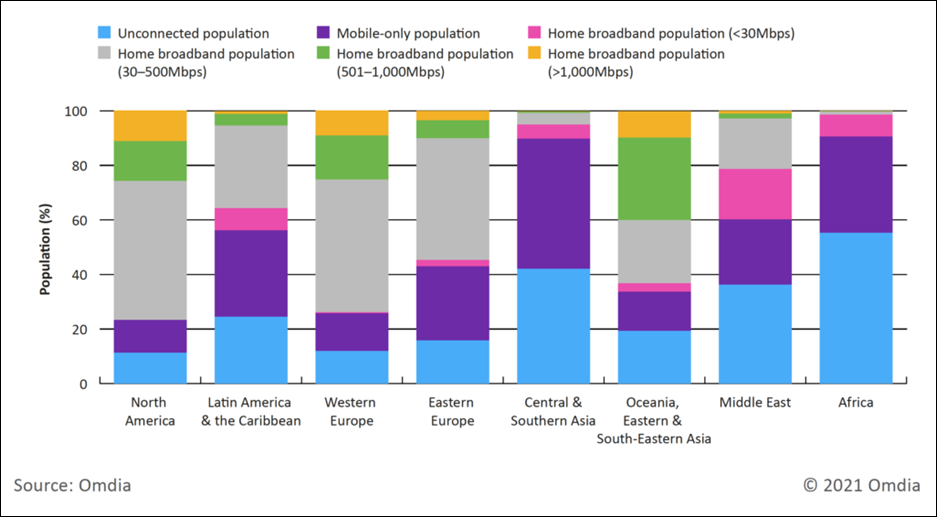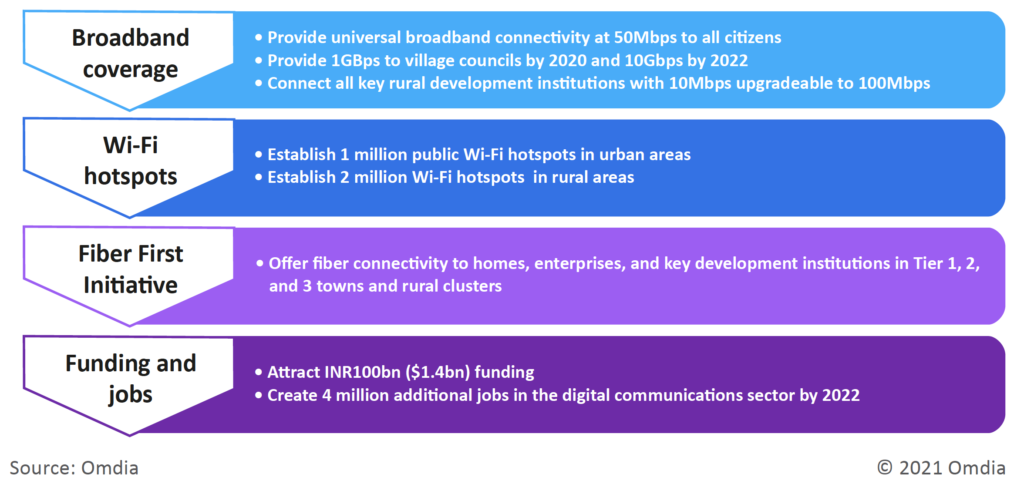Headlines of the Day
India toward the bottom of the Fiber Development Index
Fiber investment is vital to the quality delivery of all data services and therefore merits thorough contextual analysis. Unlike other fiber benchmarks that largely track coverage or household penetration, the FDI includes a wider set of metrics including business penetration, mobile cell site fiber penetration, fiber backbone investment, and overall average download and upload speed in addition to the standard fiber household coverage and household penetration.
Fiber investment is an essential metric for government institutions, network operators, and other stakeholders such as media companies and other interested parties to track. As a broadband access technology, optical fiber provides an optimized, highly sustainable, and future-proof quality service. This superior level of quality is essential for the development of future digital services and applications across all verticals including (but not limited to) entertainment, education, home working, corporate services, smart cities, and health. With increased efficiency stimulating greater innovation, high-speed broadband has been proven to drive not just consumer satisfaction but national economic indicators, with additional GDP growth of 0.25–1.5% for every 10% increase in household broadband penetration and a further 0.3% increase for every doubling of speed. Only by maximizing investment in next-generation access can countries optimize their growth potential, and fiber-optic technology is key to that investment, whether this is in the backhaul or access network.
By 2026, the percentage of the global population that is connected to the internet will increase from 58% to 70%, according to Omdia’s Global Fiber Development Index. Of the 70%, 30% of the population will have access to the internet via a mobile device, and 40% will have a home fixed broadband connection. Although the connectivity divide is closing, speed and service inequalities are unfortunately widening.
In Latin America, for example, although 44% of the population will have access to fixed broadband services by 2026, only 5.3% will be on a connection delivering 500Mbps or more, and only 1% will have speeds of more than 1Gbps. In contrast, in North America the equivalent factors are 77%, 26%, and 11% respectively, and they are 66%, 40%, and 10% in Oceania, Eastern & South-Eastern Asia. At the other end of the spectrum, only 9% of the African population will have access to fixed broadband, with 84% of those users limited to speeds of less than 30Mbps.

Singapore continues to lead the Fiber Development Index in 2021, followed by South Korea, United Arab Emirates, China, and Qatar. The first European countries in the ranking are Spain and Sweden in seventh and eighth position. They are closely followed by Luxembourg and Romania. The US heads the Americas region and is positioned 18th in the world overall. The 2021 full ranking results are available here.
As a broadband access technology, optical fiber provides an optimized, highly sustainable, and future-proof quality service. “Beyond economic benefits, an all-fiber network has significant environmental benefits over both xDSL and hybrid fiber coaxial (HFC) networks,” said Michael Philpott, Research Director, Omdia. “In 2019, Telefónica (Spain) stated that its FTTH network was 85% more energy efficient than its old copper infrastructure. The operator said its FTTH initiative had saved 208GWh over three years, representing a reduction of 56,500 tons of CO2 emissions. As countries move to a greener future, fiber-optic-based communications must be part of that plan.”
Greater investment in advanced, full-fiber broadband networks, is essential to closing this digital divide.
In the global index comparing fiber development index (FDI) analysis on a country-by-country basis study by OMDIA, India is currently situated toward the bottom of the FDI but is one of the world’s largest and fastest-growing telecom markets. On the broadband front, the government finalized its National Digital Communications Policy 2018 and renamed the Telecom Commission (part of the Department of Telecommunications) the Digital Communications Commission in September of that year. The policy seeks to attract $100bn in investment and extend connectivity to all areas by 2022. It aims to implement the following broadband initiatives, to be financed through a combination of universal service obligation fund (USOF) and public-private partnerships:
- Provide universal broadband connectivity at 50Mbps to all citizens
- Provide 1Gbps connectivity to village councils by 2020 and 10Gbps by 2022
- Connect all key rural development institutions with 10Mbps upgradable to 100Mbps
- Establish 1 million public Wi-Fi hotspots in urban area
- Establish 2 million Wi-Fi hotspots in rural areas
- Fiber First Initiative to offer fiber connectivity to homes, enterprises, and key development institutions in Tier 1, 2, and 3 towns and rural clusters
- Attract INR100bn ($1.4bn) and create 4 million additional jobs in the digital communications sector by 2022
India’s broadband initiatives

By March 2020 the government reported that 14 universal service projects were underway.
In December 2019 the government launched the National Broadband Mission (NBM) with the following key objectives:
- Broadband connectivity to all villages by the end of 2022
- Investment of INR70tn ($944bn) including INR7tn from USOF
- Laying of 3 million kilometers of optical-fiber cable and increasing the tower density from 0.42 to 1.00 towers per 1,000 people by 2024
- Enabling universal and equal access to broadband services across India, mainly in rural and remote areas
In March 2019 the state-owned telco BSNL launched a new initiative with the support of the national regulator TRAI: Digital Gram Sewaks will deliver high-speed optical fiber internet to rural areas. The operator has partnered with local entrepreneurs in these areas to provide connections to homes using BSNL’s network. The partnership works on a revenue share basis whereby local firms maintain the last mile of connectivity to customers. Through the initiative, customers are given speeds of up to 100Mbps along with various options for daily data downlink allowances ranging from 5GB to 50GB per day.
By January 2020, more than 146,717 village councils were connected by optical-fiber cable, and 132,993 village councils were service ready. The government also aims to offer last-mile connectivity through Wi-Fi or any other suitable technology to access broadband services. It aims to provide five access points (two access points at public places and three access points at government institutions such as schools and hospitals) per village council.
Telecom facilities
Sharing of passive infrastructures such as buildings, towers, dark fiber, duct space, and right of way is permitted (and mandated) for a set period of time for operators holding valid unified access service licenses (UASLs). The Unified License (UL) also allows for the provisioning of point-to-point bandwidth from one licensee’s infrastructure (within the service area) to other licensed telecom service providers
(TSPs) for their own use (resale not to be permitted). Sharing of switches by licensees for providing other licensed services is permitted. The regulator has prioritized updating the regulatory framework
to advocate active as well as passive remedies. In March 2017, TRAI published recommendations on the proliferation of broadband through public Wi-Fi networks. As per the recommendation, it proposed to amend the terms of the TSP license to allow the sharing of active infrastructure, in line with the UL. In addition, it recommended that clarification should be provided on the sharing of active Wi-Fi infrastructure such as Wi-Fi routers, access points, and backhaul.
The regulator has been proactive in updating licensing conditions to ensure the country has the best chance of reaching good levels of fiber coverage. Currently, passive infrastructure such as dark fiber, towers, and duct space can be created and shared by Infrastructure Providers Category-I (IP-I) and TSPs, but active infrastructure creation and sharing is permitted for telecom licensees only. However, in March 2020, TRAI recommended that the IP-I registration holder should be given permission to own, establish, maintain, and work all infrastructure items, equipment, and systems that are required for establishing wireline access network, RAN, and transmission links. The scope of the IP-I Registration now covers right of way, optical fiber, feeder cable, antenna, duct space, base station, tower, in-building solution (IBS), distributed antenna system (DAS), and so on, so IP-I can share passive as well as active infrastructure.
CT Bureau















You must be logged in to post a comment Login